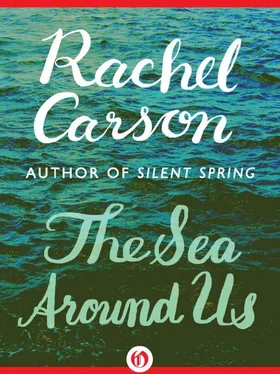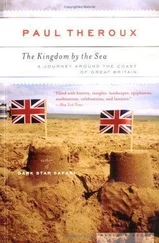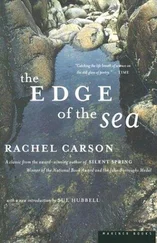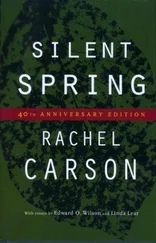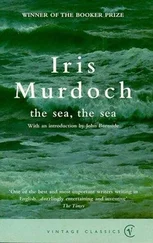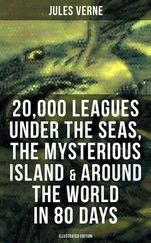Other photographs give fresh evidence of life at great depths. Tracks and trails cross the sea floor and the bottom is studded with small cones built by unknown forms of life or with holes inhabited by small burrowers. The Danish research vessel Galathea brought up living animals in dredges operated at great depths, where only recently it was supposed life would be too scanty to permit such sampling. These findings of the dynamic nature of the sea are not academic; they are not merely dramatic details of a story that has interest but no application. They have a direct and immediate bearing on what has become a major problem of our time.
Although man’s record as a steward of the natural resources of the earth has been a discouraging one, there has long been a certain comfort in the belief that the sea, at least, was inviolate, beyond man’s ability to change and to despoil. But this belief, unfortunately, has proved to be naïve. In unlocking the secrets of the atom, modern man has found himself confronted with a frightening problem—what to do with the most dangerous materials that have ever existed in all the earth’s history, the by-products of atomic fission. The stark problem that faces him is whether he can dispose of these lethal substances without rendering the earth uninhabitable.
No account of the sea today is complete unless it takes note of this ominous problem. By its very vastness and its seeming remoteness, the sea has invited the attention of those who have the problem of disposal, and with very little discussion and almost no public notice, at least until the late ’fifties, the sea has been selected as a “natural” burying place for the contaminated rubbish and other “low-level wastes” of the Atomic Age. These wastes are placed in barrels lined with concrete and hauled out to sea, where they are dumped overboard at previously designated sites. Some have been taken out 100 miles or more; recently sites only 20 miles offshore have been suggested. In theory the containers are deposited at depths of about 1000 fathoms, but in practice they have at times been placed in much shallower waters. Supposedly the containers have a life of at least 10 years, after which whatever radioactive materials remain will be released to the sea. But again this is only in theory, and a representative of the Atomic Energy Commission, which either dumps the wastes or licenses others to do so, has publicly conceded that the containers are unlikely to maintain “their integrity” while sinking to the bottom. Indeed, in tests conducted in California, some have been found to rupture under pressure at only a few hundred fathoms.
But it is only a matter of time until the contents of all such containers already deposited at sea will be free in the ocean waters, along with those yet to come as the applications of atomic science expand. To the packaged wastes so deposited there is now added the contaminated run-off from rivers that are serving as dumping grounds for atomic wastes, and the fallout from the testing of bombs, the greater part of which comes to rest on the vast surface of the sea.
The whole practice, despite protestations of safety by the regulatory agency, rests on the most insecure basis of fact. Oceanographers say they can make “only vague estimates” of the fate of radioactive elements introduced into the deep ocean. They declare that years of intensive study will be needed to provide understanding of what happens when such wastes are deposited in estuaries and coastal waters. As we have seen, all recent knowledge points to far greater activity at all levels of the sea than had ever been guessed at. The deep turbulence, the horizontal movements of vast rivers of ocean water streaming one above another in varying directions, the upwelling of water from the depths carrying with it minerals from the bottom, and the opposite downward sinking of great masses of surface water, all result in a gigantic mixing process that in time will bring about universal distribution of the radioactive contaminants.
And yet the actual transport of radioactive elements by the sea itself is only part of the problem. The concentration and distribution of radioisotopes by marine life may possibly have even greater importance from the standpoint of human hazard. It is known that plants and animals of the sea pick up and concentrate radiochemicals, but only vague information now exists as to details of the process. The minute life of the sea depends for its existence on the minerals in the water. If the normal supply of these is low, the organisms will utilize instead the radioisotope of the needed element if it is present, sometimes concentrating it as much as a million times beyond its abundance in sea water. What happens then to the careful calculation of a “maximum permissible level”? For the tiny organisms are eaten by larger ones and so on up the food chain to man. By such a process tuna over an area of a million square miles surrounding the Bikini bomb test developed a degree of radioactivity enormously higher than that of the sea water.
By their movements and migrations, marine creatures further upset the convenient theory that radioactive wastes remain in the area where they are deposited. The smaller organisms regularly make extensive vertical movements upward toward the surface of the sea at night, downward to great depths by day. And with them goes whatever radioactivity may be adhering to them or may have become incorporated into their bodies. The larger fauna, like fishes, seals, and whales, may migrate over enormous distances, again aiding in spreading and distributing the radioactive elements deposited at sea.
The problem, then, is far more complex and far more hazardous than has been admitted. Even in the comparatively short time since disposal began, research has shown that some of the assumptions on which it was based were dangerously inaccurate. The truth is that disposal has proceeded far more rapidly than our knowledge justifies. To dispose first and investigate later is an invitation to disaster, for once radioactive elements have been deposited at sea they are irretrievable. The mistakes that are made now are made for all time.
It is a curious situation that the sea, from which life first arose, should now be threatened by the activities of one form of that life. But the sea, though changed in a sinister way, will continue to exist; the threat is rather to life itself.
Silver Spring, Maryland RACHEL CARSON
October 1960
And the Earth was without form, and void; and Darkness was upon the face of the Deep.
GENESIS
BEGINNINGS ARE APT to be shadowy, and so it is with the beginnings of that great mother of life, the sea. Many people have debated how and when the earth got its ocean, and it is not surprising that their explanations do not always agree. For the plain and inescapable truth is that no one was there to see, and in the absence of eyewitness accounts there is bound to be a certain amount of disagreement. So if I tell here the story of how the young planet Earth acquired an ocean, it must be a story pieced together from many sources and containing whole chapters the details of which we can only imagine. The story is founded on the testimony of the earth’s most ancient rocks, which were young when the earth was young; on other evidence written on the face of the earth’s satellite, the moon; and on hints contained in the history of the sun and the whole universe of star-filled space. For although no man was there to witness this cosmic birth, the stars and moon and the rocks were there, and, indeed, had much to do with the fact that there is an ocean.
The events of which I write must have occurred somewhat more than 2 billion years ago. As nearly as science can tell, that is the approximate age of the earth, and the ocean must be very nearly as old. It is possible now to discover the age of the rocks that compose the crust of the earth by measuring the rate of decay of the radioactive materials they contain. The oldest rocks found anywhere on earth—in Manitoba—are about 2.3 billion years old. Allowing 100 million years or so for the cooling of the earth’s materials to form a rocky crust, we arrive at the supposition that the tempestuous and violent events connected with our planet’s birth occurred nearly 2½ billion years ago. But this is only a minimum estimate, for rocks indicating an even greater age may be found at any time. [2] Our concept of the age of the earth is constantly undergoing revision as older and older rocks are discovered and as methods of study are refined. The oldest rocks now known in North America are in the Canadian Shield area. Their precise age has not been determined, but some from Manitoba and Ontario are believed to have been formed about 3 billion years ago. Even older rocks have been discovered in the Karelia Peninsula in the U.S.S.R., and in South Africa. Geologists are generally of the opinion that present concepts of geologic time will be considerably lengthened in the future. Tentative adjustments of the length of the various periods have already been made (see chart above) and the age of the Cambrian has been pushed back 100 million years compared with the dating assigned to it a decade ago. It is in that immense and shadowy time that preceded the Cambrian, however, that the greatest uncertainty exists. This is the time of the pre-fossiliferous rocks. Whatever life may have inhabited the earth during that time has left few traces, although by indirect evidence we may infer that life existed in some abundance before its record was written in the rocks. By studies of the rocks themselves geologists have established a few good benchmarks standing out in those vast stretches of time indicated on the chart as the Proterozoic and Archeozoic Eras. These indicate a billion-year age for the ancient Grenville Mountains of eastern North America. Where these rocks are exposed at the surface, as in Ontario, they contain large amounts of graphite, giving silent testimony to the abundance of plant life when these rocks were forming, for plants are a common source of carbon. An age-reading of 1,700,000,000 years has been obtained in the Penokean Mountains of Minnesota and Ontario, formerly known to geologists as the Killarney Mountains. The remains of these once lofty mountains are still to be seen as low, rolling hills. The discovery of even older rocks in Canada, Russia, and Africa, dating back more than 3 billion years, suggests that the earth itself may have been formed about 4½ billion years ago.
Читать дальше
